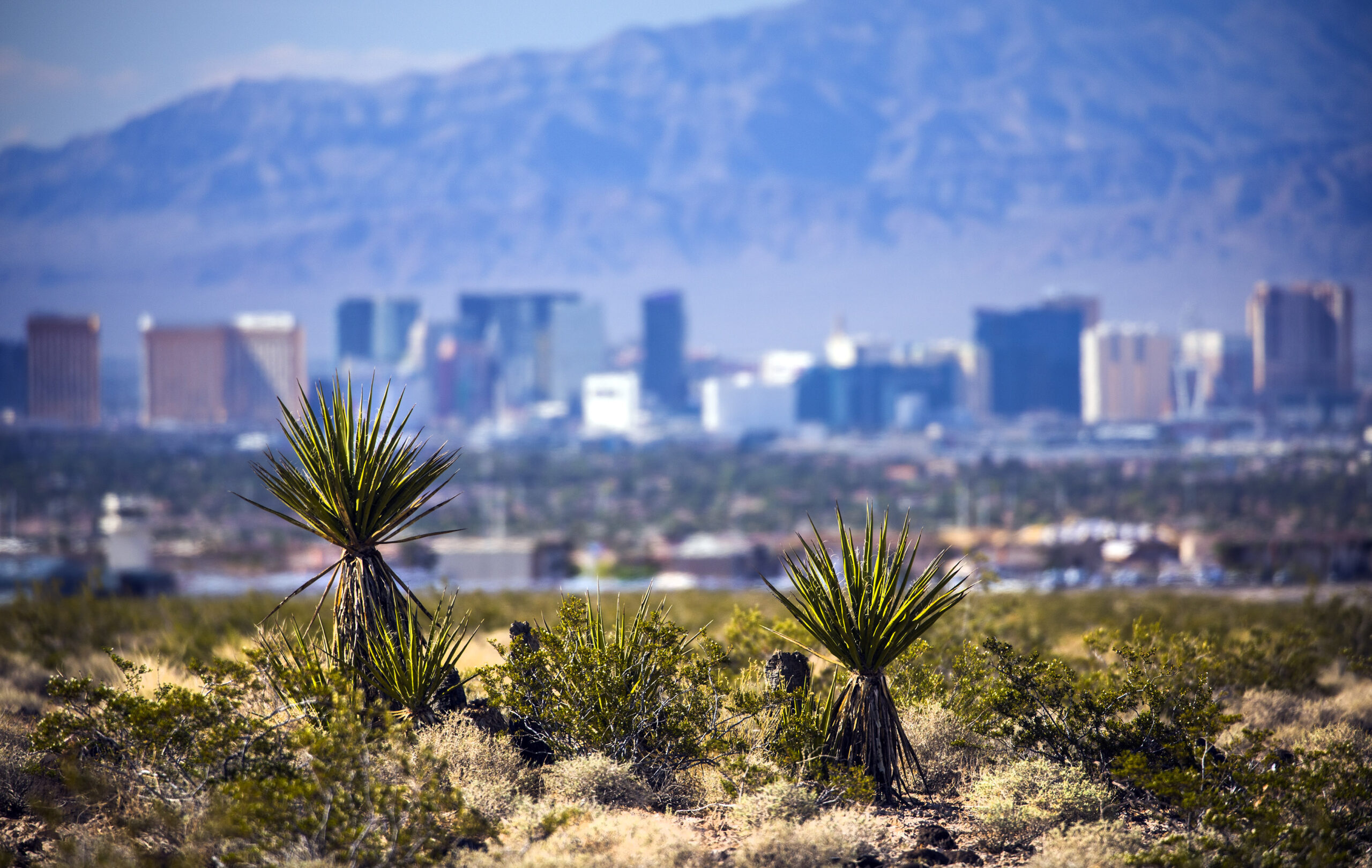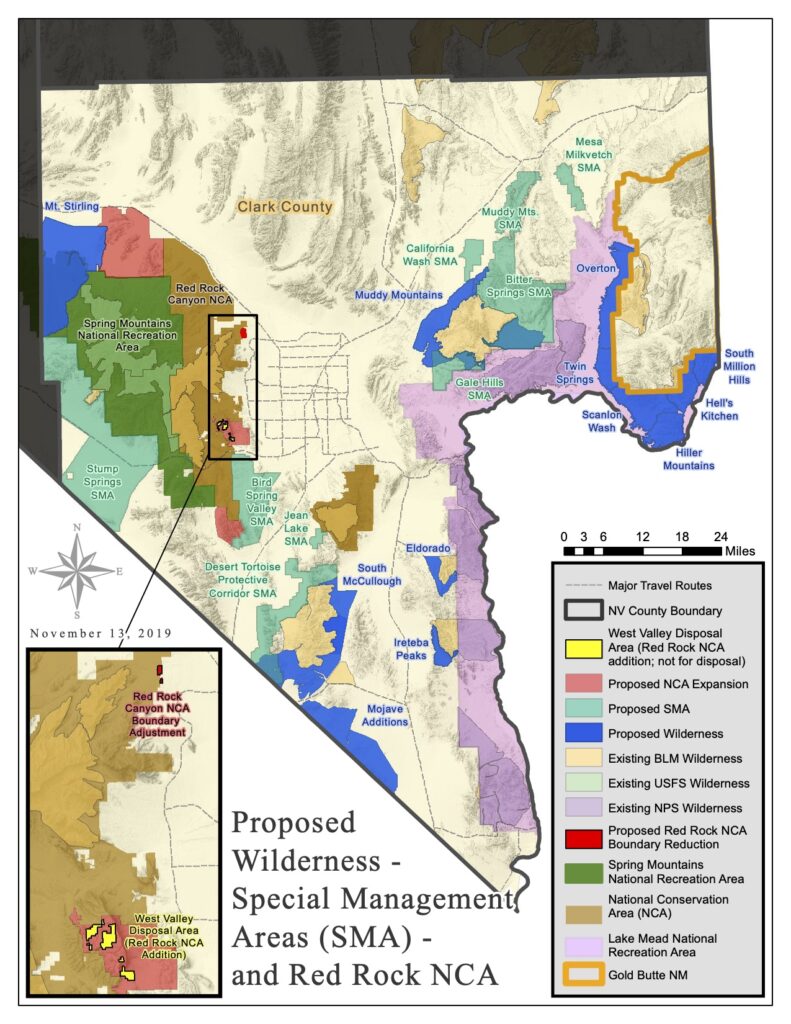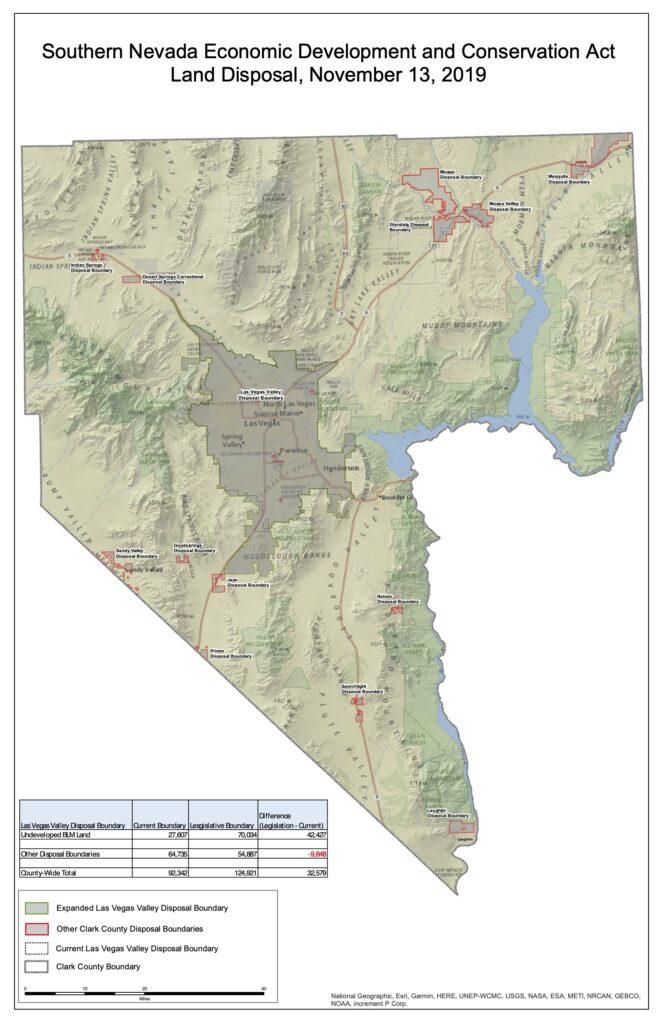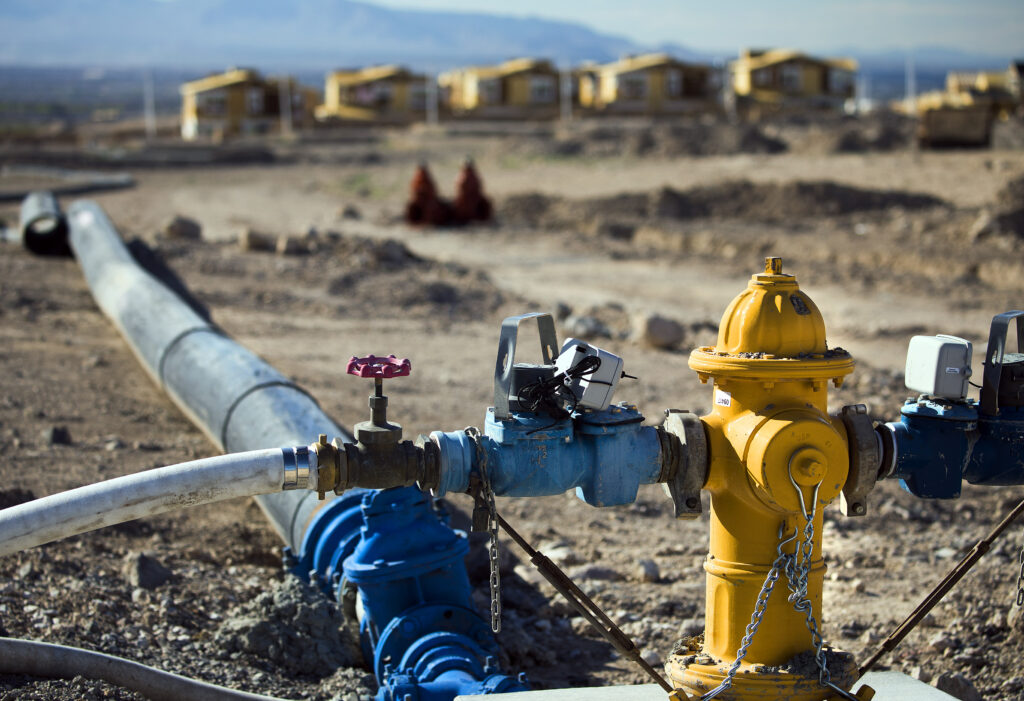Climate change, conservation and development: Reshuffling the deck on the Las Vegas lands bill

What is the Clark County lands bill really about? It all depends who you ask.
For more than two years, Clark County officials have worked on crafting a proposal to expand the federal public land available for development, while meeting their responsibilities to protect imperiled species such as the Mojave desert tortoise. In 2018, the County Commission voted to send the proposal to Congress with buy-in from developers but criticism from environmental groups.
In recent weeks, that criticism — that the bill would subvert environmental laws and undermine climate change efforts — has reached an apex, most notably during a heated KNPR segment.
U.S. Sen. Catherine Cortez Masto is working to change the conversation, especially as it relates to conservation. To do that, the senator’s staff began floating legislative language — known as a “discussion draft” — Tuesday that aims to resolve some of the most controversial aspects of the county’s plan.
In an interview Tuesday afternoon, Cortez Masto said that the purpose of the discussion draft was to foster a new round of discussions that moves groups toward finding common ground.
“It should go toward a final product that really does allow Clark County to plan for the growth in a sustainable, predictable and responsible manner, while also protecting our pristine lands and environment,” she said. “At the end of the day, the county has to plan. We have a growing community and population there. We need to make sure they have the ability to plan for that [and] be flexible in a state where 85 percent of the land is owned by the federal government.”
The proposal attempts to strike a balance. It aims to satisfy Clark County’s concerns over limits on future growth while addressing concerns from a conservation community with split opinions.
Still, the process is far from over. Negotiations over the proposed bill are likely to continue. The proposal is just draft legislation. It has not been introduced in Congress. Cortez Masto said that she plans to continue working with the delegation, the county and groups to craft final legislation.
Shaaron Netherton, executive director for Friends of Nevada Wilderness, characterized the new draft as an improvement that protects more federal land, but she added that there is more work that needs to be done.
“It's complicated, and it takes time to work through all of the issues,” she said.
Although it could protect more than twice as much federal land from development, concerns remain over what the proposal might mean for growth and threatened species, namely the desert tortoise. The proposal also leaves room for Las Vegas to develop southward along I-15. Such a move, a new coalition of groups has argued, could amplify the effects of climate change.
“While there are improvements from the county's disaster of a bill draft, this doesn't change the fundamental dynamic of allowing Las Vegas to sprawl outside the Las Vegas Valley," Patrick Donnelly, the Nevada director at the Center for Biological Diversity, said Tuesday evening.
Reshuffling the politics?
The new discussion draft, in many ways, is a response to nearly two years of criticism over the county’s original request, viewed by many groups as favoring development over conservation.

To offset additional development, the draft language would protect about 308,110 acres of public land as wilderness. It also expands the border of the Red Rock Canyon National Conservation Area by 69,201 acres, preserving a popular recreation destination for climbers and hikers.
The bill would expand land for the Moapa Band of Paiutes by 41,228 acres. It floats the idea of creating a new national monument. And it conditionally protects another 353,716 acres of land.
It changed language around the Endangered Species Act that several groups, from the Center for Biological Diversity to The Nature Conservancy, were concerned could undermine the law.
"It's an improvement, but we still have concerns," Donnelly said.
It removed language that concerned opponents of the Las Vegas pipeline, a proposal to pump groundwater from Eastern Nevada as a way to supplement the city’s Colorado River supply.
“What they have put together is really well-thought out and addresses many of the concerns that the conservationists raised with the draft,” said Justin Jones, a Clark County commissioner.

But some groups remained concerned that the legislation does not go far enough to address climate change. In fact, they argue the legislation could hinder the ability to tackle warming.
In a statement on Tuesday, Brian Beffort, director of the Sierra Club’s Toiyabe Chapter, thanked the senator for working to achieve a balance, but said he was concerned about the potential growth.
The bill would open up more than 42,000 acres of federal public land in the Las Vegas Valley to potential development, while it would reduce the amount open to development in other areas.
Industry groups, including the Southern Nevada Home Builders Association and the Henderson Chamber of Commerce, see a growing population on the horizon. Las Vegas is expected to add about 600,000 people over the next four decades. And they see themselves as landlocked.
Federal land managers, namely the U.S. Bureau of Land Management, control most of the land around the Las Vegas Valley. With a growing population, industry groups argue that there is a need to free up new land to lower land prices, and in turn, attract new business and housing.
“We're a growing community,” Amber Stidham, director of government affairs for the Henderson Chamber of Commerce, said on Tuesday. “I understand the need for not becoming too much of a sprawled community. But the fact is that 85 percent of the state is public land. We are one of the fastest-growing communities in the nation. And we're surrounded by federal public land.”
The legislation would direct growth around the I-15 corridor toward California.
Yet land use is tied to addressing climate change. And some groups worry directing growth toward the outskirts of the valley, rather than directing growth up, could only make addressing climate change that much more difficult.
“Las Vegas is already one of the fastest-warming cities in the nation, our air quality is among the worst in the nation, and our water future is uncertain at best,” Beffort wrote in an email after the discussion draft was released. “This legislation could be a vehicle for meaningful climate action. But in what we've seen so far, it isn't. We're afraid it's only going to make things worse.”
This tension over growth has been present from the start.

A delayed commission vote
In 2017, representatives from conservation and environmental organizations huddled in an office at Clark County’s Department of Air Quality. It’s an agency that has a misleading name.
For years, it has done much more than help regulate emissions from vehicles and industry. One example of its breadth: It is responsible for ensuring compliance with endangered species rules. For this reason, it is looking to restructure as the Department of Environment and Sustainability.
At that meeting in 2017, representatives from the conservation community were briefed on a new project. For several attendees of the meeting, it was the first time that they were hearing about the proposal. The department was seeking congressional legislation that would secure more land for development by adjusting the boundaries of federal public land within the county.
Immediately, there were environmental concerns. The county’s plan would direct the trajectory of Las Vegas’ growth for decades. How would it affect federal public land used for recreation and conservation? How would it affect imperiled species, namely the declining Mojave desert tortoise population? Did it comply with the Endangered Species Act? The proposal could protect more federal public land. But was it long-lasting enough to offset the effect of new development?
The groups were told that the County Commission would weigh the proposal at its next meeting.
That didn’t end up happening.
The groups were successful in delaying the county’s process. It wasn’t until June 2018 that the commission voted unanimously to move forward with the proposal. Once the vote happened, the county continued tweaking the bill as the delegation started looking at crafting its own draft.
But by the time that vote came around, environmental groups found themselves with differing opinions. Most of them were opposed to the bill or neutral. Other groups, such as the Center for Biological Diversity, were vehemently opposed. Save added conservation and a few provisions, the Sierra Club said it was “a terrible step forward” (emphasis taken from the group’s comment letter).
Two groups — the Nevada Conservation League and the Conservation Lands Foundation — commented in support of the proposal, arguing it was only a first step; things could change.
After the vote, groups began directing their concerns toward the delegation, and their positions revealed a significant tension over what environmental goals the bill should accomplish.

A more sprawling debate
Last week, a new coalition came to the table: the Nevada Climate Justice Coalition.
The coalition, comprising 350.org, Mi Familia Vota, Moms Clean Air Force, Ecomadres, PLAN, Sierra Club and the Sunrise Movement, formed in response to the county’s initial proposal. The goal of the coalition was to bring more urgency to the justice and equity issues associated with sprawl. And on Monday, the coalition released a letter to the delegation telling it to slow down.
Former County Commissioner Chris Giunchigliani also signed the letter. Giunchigliani, who ran for governor in 2018, originally voted for the county’s proposal but has withdrawn her support.
The coalition recommended the delegation “postpone passing legislation that has the potential to expand Las Vegas’ footprint — and the associated climate and equity impacts — until strong sustainability, climate-resiliency and equity policies are in place at the county level.”
Their ask offers an alternative approach to the course many groups have been taking.
If the bill is going to allow for the potential southward expansion of the Las Vegas Valley toward the California border, they want assurances in advance that the county will take climate change effects into account. How will more development increase the urban heat island? What will it mean to have more vehicles on the road? Will the county prioritize and incentivize infill first?
The proposed legislation expands the federal land available for purchase by developers. But it does not guarantee that all of that land — about 32,000 acres — will be sold to developers.
“If this public lands bill moves forward, that does not mean the lands are going to be [sold],” said Stidham, with the chamber. “It means that we are providing more authority to the municipalities."
Andy Maggi, executive director of the Nevada Conservation League, said that it will be up to policymakers to ensure that climate change is taken into account. He added that “there is nothing in here that says the historic trends of Southern Nevada have to continue.”
But others believe that simply expanding the land available to developers, will squeeze natural ecosystems in an area where there is already increased development pressure on public land.
Shaun Gonzales, who writes the Mojave Desert Blog and is on the board of Basin and Range Watch, said that environmentalists should not rely on politicians to check desert development.
“They can't guarantee who is going to be on that commission down the road,” he said. “Once the land is made available to developers, that begets its own political and economic pressures.”
Most groups agree that climate change should be part of the equation as the Las Vegas Valley looks at a growing population, but they ask whether the legislation is the right place to do that.
Jocelyn Torres, Nevada director for the Conservation Lands Foundation, noted that jurisdiction is multi-layered when it comes to creating policy for an issue as systemic as climate change.
“I'm not sure all the answers are in this legislation,” Torres said.
How the bill moves forward
None of this is happening in a vacuum.
Across the state, counties from Pershing to Washoe are working on bills that would change the status of federal land within their boundaries. Those processes could lead to more conserved federal land for recreation and wildlife. They could also open more public land to development.
At the same time, the military is proposing significant expansions of two testing ranges — one in Southern Nevada and one in Northern Nevada — that are used to train for modern air combat.
In an interview with reporters last week, Rep. Mark Amodei proposed combining some of the legislation to make passage before Congress more likely. Amodei, in the interview, also warned that it would be more difficult to pass legislation after July 4th as attention shifted to the election.
When asked how the Clark County legislation could move through Congress, Cortez Masto said she was not sure how the legislation would proceed. Her focus, she said, is drafting a final bill.
“I don’t know how it’s going to move,” Cortez Masto said. “It’s important that we work with the county and local government and the stakeholders who are interested in working together to find common ground to come up with a final product. And then I will work with our delegation in finding a vehicle and figuring out how we pass it through Congress.”
Humberto Sanchez contributed reporting to this article.
